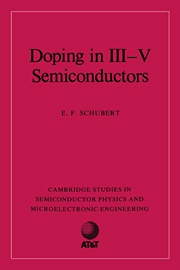Book contents
- Frontmatter
- Contents
- Foreword
- Preface
- List of symbols
- Introduction
- 1 Shallow impurities
- 2 Phenomenology of deep levels
- 3 Semiconductor statistics
- 4 Growth technologies
- 5 Doping with elemental sources
- 6 Gaseous doping sources
- 7 Impurity characteristics
- 8 Redistribution of impurities
- 9 Deep centers
- 10 Doping in heterostructures, quantum wells, and superlattices
- 11 Delta doping
- 12 Characterization techniques
- Appendix A Properties of III–V semiconductors
- Appendix B Constants and conversions
- References
- Index
12 - Characterization techniques
Published online by Cambridge University Press: 05 October 2010
- Frontmatter
- Contents
- Foreword
- Preface
- List of symbols
- Introduction
- 1 Shallow impurities
- 2 Phenomenology of deep levels
- 3 Semiconductor statistics
- 4 Growth technologies
- 5 Doping with elemental sources
- 6 Gaseous doping sources
- 7 Impurity characteristics
- 8 Redistribution of impurities
- 9 Deep centers
- 10 Doping in heterostructures, quantum wells, and superlattices
- 11 Delta doping
- 12 Characterization techniques
- Appendix A Properties of III–V semiconductors
- Appendix B Constants and conversions
- References
- Index
Summary
Doping and other materials parameters influence the properties of III–V devices in a profound manner. Examples of device parameters which are strongly influenced by the defect and doping concentration are the radiative efficiency of a laser, the minority carrier lifetime in the base of a bipolar transistor, the carrier mobility in the channel of a field-effect transistor, or the quantum efficiency of a pin photo-diode. In this chapter, characterization techniques are discussed that relate directly to shallow impurities as well as deep centers. The characterization techniques are categorized as (i) electronic (ii) optical, and (iii) chemical and structural techniques. Fundamental aspects of characterization techniques as well as practical ‘hints’ for the experimentalist are emphasized.
Electronic characterization techniques
Many properties of semiconductors that relate directly to impurities or defects can be assessed by electrical measurements. Such measurements include current–voltage, capacitance–voltage, resistivity, magnetoresistance, and impedance measurements. Frequently, temporal transients of such measurements are of interest, for example the capacitance transient after a semiconductor has been subjected to an electrical pulse. In this section, the Hall effect, capacitance–voltage (CV) profiling technique, deep level transient spectroscopy (DLTS), thermally stimulated capacitance (TSCAP), thermally stimulated current (TSC), and admittance spectroscopy are discussed.
Hall effect measurements
Hall effect measurements (Hall, 1879) allow one to determine the (majority) Hall carrier concentration of unipolar semiconductors in which the minority carrier concentration can be neglected.
Information
- Type
- Chapter
- Information
- Doping in III-V Semiconductors , pp. 482 - 540Publisher: Cambridge University PressPrint publication year: 1993
Accessibility standard: Unknown
Why this information is here
This section outlines the accessibility features of this content - including support for screen readers, full keyboard navigation and high-contrast display options. This may not be relevant for you.Accessibility Information
- 1
- Cited by
